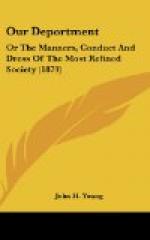THE MARRIAGE CEREMONIALS OF A WIDOW.
The marriage ceremonials of a widow differ from that of a young lady in not wearing the veil and orange blossoms. She may be costumed in white and have her maids at the altar if she pleases. This liberty, however, has only been given her within a few years. On her wedding cards of invitation, her maiden name is used as a part of her proper name; which is done in respect to her parents. Having dropped the initials of her dead husband’s name when she laid aside her mourning, she uses her Christian name. If she has sons or unmarried daughters at the time she becomes again a wife, she may prefix the last name of her children to her new one on all ceremonious occasions in which they are interested in common with herself. This respect is really due them, and etiquette permits it, although our social usages do not command its adoption. The formalities which follow the marriage of a widow can seldom be regulated in the same manner as those of a younger bride. No fixed forms can be arranged for entertainments, which must be controlled by circumstances.
INVITATIONS.
Wedding invitations should be handsomely engraved in script. Neither Old English nor German text are admissible in invitations. The following is given as the latest form for invitations:
[Illustration:
Mr. & Mrs. Theodore Grosser
request your presence at the marriage
of their daughter,
=Miss Felicia Grosser=
to
=Mr. Julius C. Forsyth=,
on Wednesday, September 5th, at
12 o’clock.
St. Luke’s Church,
Cass Avenue.]
This invitation requires no answer. Friends living in other towns and cities receiving it, inclose their cards, and send by mail. Residents call on the family within the prescribed time, or as soon after as possible.
The invitation to the wedding breakfast is enclosed in the same envelope, generally conveyed on a square card, the same size as the sheet of note paper which bears the invitation for the ceremony after it has been once folded across the middle. The following is one of the adopted forms:
[Illustration:
At Home,
Wednesday, September 5th,
from 12 until 3 o’clock.
20 Main Avenue.]
The separate cards of the bride and groom are no longer necessary.
The card of admission to the church is narrower, and is plainly engraved in large script, as follows:
[Illustration:
St. Luke’s Church,
Ceremony at 12 o’clock.]
Generally only half an hour intervenes between the ceremony and the reception.
DUTIES OF THOSE INVITED.
People who receive “At Home” wedding invitations, are expected to acknowledge them as soon as received, and never fail to accept, unless for some very good reason. Guests invited to the house, or to a marriage feast following the ceremony, should not feel at liberty to decline from any whim or caprice.




